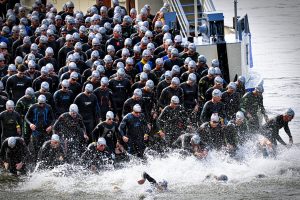duathlon
If you’re interested in trying a multi-sport event but aren’t keen on swimming, a duathlon might be perfect for you. Duathlons combine running and cycling in a run-bike-run format, making it an excellent choice for athletes who enjoy running and biking or for triathletes who want to improve their bike and run endurance without the swim. Whether you’re preparing for a local race or using duathlons as part of your triathlon training, this post will guide you through duathlon formats, essential training tips, and race-day strategies.
What is a Duathlon?
A duathlon consists of a run, followed by a bike segment, and ending with another run. The three legs challenge your cardiovascular endurance, leg strength, and mental resilience as you transition between running and cycling twice in one race.
Common Duathlon Distances:
- Sprint Duathlon: 5km run, 20km bike, 2.5km run
- Standard Duathlon: 10km run, 40km bike, 5km run
- Long-Distance Duathlon: Distances vary, but they’re often 10-20km for the first run, 60-90km bike, and 10-15km second run
- Off-Road Duathlon: Run and mountain bike on trails, with distances and terrain depending on the event
The distances vary widely based on the event and can be customized to suit beginners or advanced athletes. Each distance offers unique challenges and rewards, with Sprint and Standard duathlons being most popular for beginners and triathletes looking to incorporate duathlons into their training.
Why Train for a Duathlon?
Duathlons offer a great way to build endurance, strengthen your running and cycling, and improve transition skills. For triathletes, training for a duathlon can improve cycling-to-run transition, an area that often challenges athletes in triathlons. Duathlons are also a great option for winter training or when open water swimming isn’t available. Benefits include:
- Improved Endurance and Cardiovascular Fitness: Running and biking in succession challenges your heart and lungs, building aerobic capacity.
- Enhanced Bike-to-Run Transition Skills: Practicing two runs with a bike segment in between prepares your legs and mind for quicker, more efficient transitions.
- Mental Resilience: Duathlons test your ability to maintain speed and push through fatigue after the initial run and bike leg.
Key Components of Duathlon Training
To prepare effectively for a duathlon, focus on balanced training that builds both running and cycling endurance. Incorporate transition practice to smooth out your bike-to-run switch, and train at a variety of paces to boost both speed and stamina.
1. Running Training for Duathlons
Since duathlons start and finish with a run, it’s essential to build both speed and endurance in your running. Check out our Running Tips page for more.
Speed Workouts:
- Intervals: Incorporate short intervals, such as 400m repeats, at a pace faster than race speed. Rest between intervals to build leg speed and cardiovascular fitness.
- Tempo Runs: Sustained efforts of 20–30 minutes at a moderately hard pace help develop your lactate threshold, enabling you to run faster for longer periods.
Endurance Runs:
- Build your endurance with longer, steady runs. Aim for a weekly long run, gradually increasing distance to match the race distance. Running at a comfortable pace builds aerobic endurance without risking injury or burnout.
Brick Runs:
- Run after cycling to mimic race-day transitions and prepare your legs for the bike-to-run switch. Start with short runs of 10–15 minutes off the bike, progressing to longer runs as you get more comfortable. Our page on Advanced Training discusses brick training in more depth.
2. Cycling Training for Duathlons
Since cycling is the longest segment in a duathlon, it’s essential to develop cycling strength and endurance. Have a look at our Advanced Training and Cycling Tips pages for more detail.
Endurance Rides:
- Aim for one long, steady ride each week, gradually increasing the distance to at least match or exceed your race distance. This builds the stamina needed for the duathlon bike leg and helps you maintain a steady effort on race day.
Interval and Hill Training:
- Add intervals to improve power and speed. Try sessions like 5 x 3 minutes at a high intensity with a 2-minute rest in between.
- Hill repeats strengthen your legs, build cycling endurance, and improve your ability to tackle elevation changes.
Brick Workouts:
- After a bike session, immediately follow with a short run. These sessions simulate the unique feeling of running on fatigued legs and teach your body to transition smoothly from cycling to running. Start with shorter brick runs and gradually increase the distance as your fitness improves.
Preparing for Transitions
Transitions are critical in a duathlon, as they impact your overall time and energy expenditure. Practicing your transitions will make you more efficient on race day.
Run-to-Bike (T1) Transition:
- Set up your bike and gear for easy access. Practice slipping into your cycling shoes, putting on your helmet, and mounting your bike quickly and safely.
- Identify a nearby marker like a tree or support tent to help identify where your bike is in the heat of the race. You won’t be able to mark your own spot.
- Keep your bike in a low gear so you can pedal efficiently when you start riding.
Bike-to-Run (T2) Transition:
- Dismount smoothly, racking your bike securely before starting the run. Practice quickly swapping your cycling shoes for running shoes.
- Start the second run with short, quick steps to ease into the pace, allowing your legs to adjust to running.
Sample Duathlon Training Plan
Here’s a simple weekly training structure for a Sprint duathlon (5k run, 20k bike, 2.5k run). Adjust distances and intensities based on your fitness level and race distance.
Weekly Schedule:
- Monday: Rest or active recovery
- Tuesday: Interval run workout (e.g., 6 x 400m at race pace)
- Wednesday: Endurance ride (40–60 minutes at a steady pace)
- Thursday: Tempo run (20–30 minutes at a challenging pace)
- Friday: Rest or strength training (focus on legs and core)
- Saturday: Brick workout (20k bike + 10–15 minute run)
- Sunday: Long run (30–45 minutes at a comfortable pace)
This plan balances intensity and recovery, building both speed and endurance while incorporating brick workouts to practice transitions.
Duathlon Race-Day Tips
A few simple race-day strategies can help ensure a smooth, enjoyable race. Familiarizing yourself with the course, setting up your transition area efficiently, and pacing yourself will make a big difference.
1. Familiarize Yourself with the Course:
- If possible, preview the race course or study the map to identify key points, including hills, sharp turns, and the transition area. There’ll often be a race briefing before the race.
2. Set Up an Organized Transition Area:
- Keep your gear tidy and easy to access. Set up your bike shoes, helmet, and any nutrition within reach, in the order in which you’ll need them, and avoid clutter that could slow you down.
3. Start Steady on the First Run:
- Avoid sprinting off the line. Starting at a steady pace will help conserve energy for the bike leg and ensure you have stamina left for the second run.
4. Pace the Bike Segment:
- Push hard but avoid going all out on the bike, especially if you’re new to duathlons. Save some energy for the final run to avoid the “jelly legs” feeling when you transition from biking to running.
5. Ease into the Second Run:
- The second run will likely feel challenging as your legs adjust. Take shorter, quicker steps to ease into the run, focusing on maintaining a rhythm and breathing steadily.
Embracing the Duathlon Challenge
Duathlons are a unique and rewarding challenge that builds endurance, tests mental resilience, and offers a fun alternative to traditional triathlons. By balancing your run and bike training, practicing transitions, and pacing yourself, you’ll set yourself up for a successful race day. Whether you’re a beginner looking for a swim-free introduction to multi-sport racing or a seasoned triathlete seeking an exciting off-season challenge, duathlons are a fantastic way to improve fitness and build race-day confidence. Good luck, and enjoy the journey!



